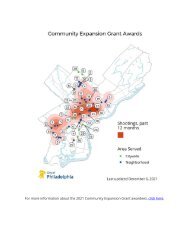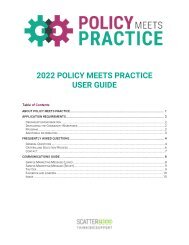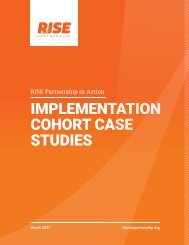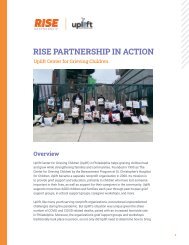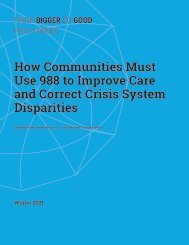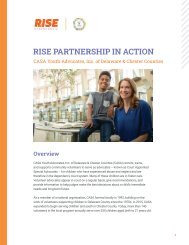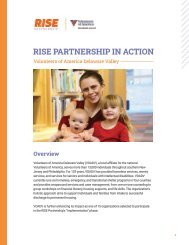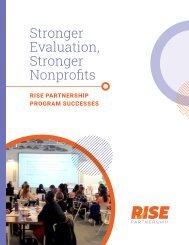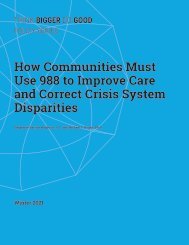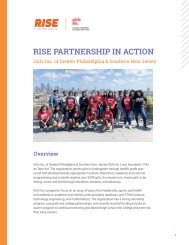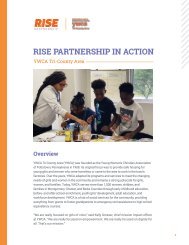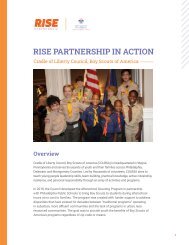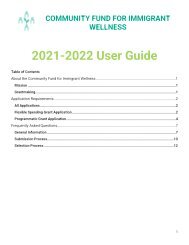Map the gap_ iteratively bridging theory and practice to address housing insecurity
You also want an ePaper? Increase the reach of your titles
YUMPU automatically turns print PDFs into web optimized ePapers that Google loves.
CULTURAL PRODUCTION<br />
<strong>Map</strong> <strong>the</strong> <strong>gap</strong>: <strong>iteratively</strong> <strong>bridging</strong> <strong>the</strong>ory<br />
<strong>and</strong> <strong>practice</strong> <strong>to</strong> <strong>address</strong> <strong>housing</strong> <strong>insecurity</strong><br />
in <strong>the</strong> urban environment<br />
Diana Susan Nicholas 1 , Samantha Stein 2 , Kristin Giordano 1 , Thanh My Nguyen 1 ,<br />
Yvonne Michael 1<br />
1 Drexel University, Philadelphia, PA<br />
2 University of Pennsylvania, Philadelphia, PA<br />
ABSTRACT: According <strong>to</strong> <strong>the</strong> Robert Wood Johnson Foundation Commission <strong>to</strong> Build a<br />
Healthier America, health <strong>and</strong> well-being depend more on where we live, learn, work <strong>and</strong> play<br />
than on medical care, which accounts for only an estimated 10 <strong>to</strong> 15 percent of preventable<br />
early deaths (Brawer, R. et al., 2016). Housing <strong>insecurity</strong>, marked by uninhabitable living<br />
conditions, uncertainty regarding capacity <strong>to</strong> pay rent, <strong>and</strong> multiple relocations, threatens <strong>the</strong><br />
physiological <strong>and</strong> mental health of individuals <strong>and</strong> overburdens infrastructure (S<strong>and</strong>el et al.,<br />
2018). Our current research reveals that <strong>housing</strong> <strong>insecurity</strong> is exacerbated via disconnects<br />
between legal affordances, community-based organization (CBO) responsibility<br />
misconception, <strong>and</strong> a lack of resources. This paper will examine <strong>the</strong> research <strong>and</strong><br />
development philosophies <strong>and</strong> processes which substantiate <strong>Map</strong> <strong>the</strong> Gap, a transdisciplinary,<br />
in-development mobile-Health intervention/prevention <strong>to</strong>ol intended <strong>to</strong> reduce <strong>the</strong> burden of<br />
<strong>housing</strong> <strong>insecurity</strong> in Philadelphia. The <strong>to</strong>ol takes its name from several efforts currently<br />
underway <strong>to</strong> consider <strong>the</strong> <strong>gap</strong> in income required for families <strong>to</strong> avoid eviction. This research<br />
group has developed an emerging framework <strong>to</strong> approach <strong>the</strong> community work required <strong>to</strong><br />
cultivate efficient, effective relationships between Philadelphia residents <strong>and</strong> <strong>the</strong> built<br />
environment. It is anticipated that <strong>Map</strong> <strong>the</strong> Gap will play a critical role in health care <strong>and</strong><br />
wellness promotion. In addition <strong>to</strong> enabling Philadelphia residents <strong>to</strong> access resources which<br />
improve <strong>the</strong> built environment, <strong>the</strong> human-centered accessible architecture of <strong>the</strong> <strong>Map</strong> <strong>the</strong> Gap<br />
system itself will lay <strong>the</strong> foundation for a Culture of Health, transforming determinants of health<br />
in<strong>to</strong> constituents of health, <strong>and</strong> thus creating new imperatives for design of sociotechnical<br />
structures which transcend relational <strong>and</strong> environmental spaces.<br />
KEYWORDS: Culture of Health, Urban Housing Access, Housing Insecurity, Health <strong>and</strong><br />
Stress, Design Research for Health<br />
INTRODUCTION<br />
In order <strong>to</strong> improve health in this country, <strong>the</strong> health sec<strong>to</strong>r must work closely with those<br />
who plan <strong>and</strong> build communities, especially <strong>the</strong> community development <strong>and</strong> finance<br />
organizations that work in low-income neighborhoods <strong>to</strong> build child care centers,<br />
schools, grocery s<strong>to</strong>res, community health clinics, <strong>and</strong> affordable <strong>housing</strong>. From <strong>the</strong><br />
health perspective, our interest is less about <strong>the</strong> buildings <strong>and</strong> more about what happens<br />
in <strong>the</strong>m (Lavizzo-Mourey 2012, 218).<br />
Urban families under threat of living without an established <strong>address</strong> will experience a<br />
concurrent threat <strong>to</strong> <strong>the</strong>ir livelihood that can have serious health repercussions (Marcus 1995).<br />
To alter <strong>the</strong> stress levels of urban individuals, we must seek <strong>to</strong> structurally augment <strong>the</strong> ways<br />
that urban neighborhood environments drive such outcomes (Thoits 2010). A midcentury<br />
<strong>housing</strong> renewal that occurred in many urban American locales created a major <strong>housing</strong><br />
shortage <strong>and</strong> countless living spaces that are subst<strong>and</strong>ard <strong>and</strong> unsuitable for urban families<br />
<strong>to</strong> have healthy lives (Jacobs 1993, 3). Within <strong>the</strong> production of architecture <strong>and</strong> <strong>the</strong> lives of<br />
many urban inhabitants lie structural inequities that lead <strong>to</strong> eviction <strong>and</strong> homelessness<br />
(Desmond 2016). To ascertain <strong>and</strong> <strong>address</strong> <strong>the</strong> possible efficient <strong>and</strong> effective relationships<br />
imperative <strong>to</strong> a city with successful <strong>and</strong> equitable <strong>housing</strong>, we ask: How can architecture <strong>and</strong><br />
<strong>housing</strong> within <strong>the</strong> urban environment be democratized? What forms can <strong>the</strong> vocalizations<br />
276 <strong>Map</strong> <strong>the</strong> <strong>gap</strong>: <strong>iteratively</strong> <strong>bridging</strong> <strong>the</strong>ory <strong>and</strong> <strong>practice</strong> <strong>to</strong> <strong>address</strong> <strong>housing</strong> <strong>insecurity</strong> in <strong>the</strong> urban environment
CULTURAL PRODUCTION<br />
<strong>and</strong> internalizations of civic concern take in a his<strong>to</strong>rically disenfranchised community? What<br />
assumptions have his<strong>to</strong>rically underpinned notions of community <strong>and</strong> institutional capacity?<br />
How have such assumptions translated in<strong>to</strong> power disparities in space making? How can built<br />
environment <strong>and</strong> healthcare architecture be leveraged <strong>to</strong> de-naturalize disparities <strong>and</strong> resocialize<br />
a Culture of Health predicated on equity, sustainability, <strong>and</strong> potential <strong>to</strong> thrive? This<br />
paper will explore <strong>the</strong>se questions through an emergent community framework that has arisen<br />
across extended community co-design, feedback <strong>and</strong> input.<br />
Teasing out <strong>the</strong> hidden motives in any arena where resistance <strong>to</strong> change exists builds efficacy<br />
<strong>and</strong> community capacity <strong>to</strong> change (Kegan <strong>and</strong> Lahey 2009); <strong>the</strong> urban <strong>housing</strong> environment<br />
is an especially challenging environment. This research group argues for <strong>the</strong> examination of<br />
inherent politics, policies <strong>and</strong> possible processes embedded in modern design <strong>to</strong> discover<br />
novel, equitable processes that will create change for <strong>the</strong> families that bear <strong>the</strong> burden of<br />
current processes. Exploring <strong>the</strong> transdisciplinary <strong>and</strong> trans-temporal possiblities which<br />
connect data informants, built environment care providers, processors, <strong>and</strong> recipients, enables<br />
this group <strong>to</strong> develop a community-driven design research process. This process aims <strong>to</strong><br />
transform a legacy of inequitable development in<strong>to</strong> a cyclic, iterative, democratized design<br />
process for urban families in West Philadelphia. In examining models of potential <strong>the</strong>ory <strong>and</strong><br />
possible <strong>practice</strong> translations, as well as <strong>the</strong> ethical obligations which guide design aspirations,<br />
this paper serves as a stepping s<strong>to</strong>ne <strong>to</strong> a transdisciplinary approach <strong>to</strong> <strong>the</strong> built <strong>and</strong> social<br />
world. The work that drives this paper stems from <strong>the</strong> desire <strong>to</strong> achieve stress reduction <strong>and</strong><br />
enhance health for urban families (Lavizzo-Mourey, 2012, p. 218); this research group<br />
approaches stress reduction in <strong>the</strong> built environment via new solutions <strong>to</strong> change <strong>the</strong><br />
residential environment, wherever people may live. <strong>Map</strong> <strong>the</strong> Gap, <strong>the</strong> pro<strong>to</strong>type subject for<br />
this paper, is an in-development digital narratively-informed <strong>housing</strong> decision guidance <strong>to</strong>ol<br />
intended <strong>to</strong> optimize utilization of existing resources (connect people <strong>to</strong> community-based<br />
organizations). The ultimate outcome is <strong>to</strong> dissolve his<strong>to</strong>rical tensions between l<strong>and</strong>lords <strong>and</strong><br />
tenants. The <strong>to</strong>ol takes its name from urban planning <strong>and</strong> policy currently underway <strong>to</strong><br />
consider <strong>the</strong> <strong>gap</strong> in income required for urban dwellers <strong>to</strong> avoid eviction (hraadvisors, 2019).<br />
Currently, we have found no o<strong>the</strong>r interactive interfaces which allow l<strong>and</strong>lords <strong>and</strong> tenants <strong>to</strong><br />
virtually navigate <strong>the</strong> realities of <strong>the</strong> <strong>housing</strong> system, nor smart-applications which advise<br />
based on individual circumstance meshed with current data.<br />
<strong>Map</strong> <strong>the</strong> Gap is also unique in that it is intended <strong>to</strong> function as both a primary <strong>and</strong> secondary<br />
prevention <strong>to</strong>ol; while it will serve <strong>to</strong> prevent homelessness associated with unrepaired rental<br />
units, it will also serve as a <strong>to</strong>ol <strong>to</strong> foster self-efficacy <strong>and</strong> advocacy capacity thus reducing <strong>the</strong><br />
risk fac<strong>to</strong>rs for homelessness. <strong>Map</strong> <strong>the</strong> Gap serves <strong>to</strong> develop <strong>and</strong> maintain a healthy,<br />
workable system. Our plans <strong>to</strong> develop this <strong>to</strong>ol have been evaluated <strong>and</strong> informed by an<br />
inter-sec<strong>to</strong>ral group of experts, representing a cross-section of leaders in this area. The<br />
research group includes Public Health <strong>and</strong> Architecture practitioners <strong>and</strong> researchers with<br />
considerable experience in <strong>the</strong> urban built environment <strong>and</strong> with urban residential issues,<br />
including 20-plus years of experience in residential re-design, re-use <strong>and</strong> repair.<br />
In terms of function, <strong>Map</strong> <strong>the</strong> Gap will connect tenants, l<strong>and</strong>lords, community-based<br />
organizations, government agencies, <strong>and</strong> o<strong>the</strong>r resources in Philadelphia by 1) providing<br />
personalized navigation of Philadelphia’s <strong>housing</strong> system, 2) facilitating communication<br />
between parties, <strong>and</strong> 3) enabling service exchange (a local currency). <strong>Map</strong> <strong>the</strong> Gap is<br />
intended <strong>to</strong> be used consistently, with users engaging with various functions at regular<br />
intervals, as well as some on a trauma-informed basis. The mobile application will contain both<br />
public <strong>and</strong> private platforms <strong>to</strong> facilitate <strong>the</strong>se user-system/user-user interactions. The private<br />
platform will maintain individual data collected in bulk upon sign-up, <strong>and</strong> <strong>the</strong>n derived<br />
periodically throughout use. Housing system navigation guidance will occur over <strong>the</strong> private<br />
platform, <strong>and</strong> as a function of data inputted in<strong>to</strong> <strong>the</strong> private platform. The public platform will<br />
serve as a means for communication between l<strong>and</strong>lords, tenants, <strong>and</strong> CBO’s. I n addition <strong>to</strong><br />
providing protected chat spaces for l<strong>and</strong>lords <strong>and</strong> tenants, calendars with all unit-related<br />
responsibilities including unit check-over times, rent collection, unit upkeep, repairs, <strong>and</strong><br />
ARCC 2019 | THE FUTURE OF PRAXIS 277
CULTURAL PRODUCTION<br />
regular meetings will be shared by all users (l<strong>and</strong>lords <strong>and</strong> tenants alike) associated with each<br />
unit.<br />
1.0 A new framework for engagement voice, guidance, channels <strong>and</strong> dynamics<br />
Confronted with a problem as complex as racism, we cannot afford <strong>to</strong> let ourselves be<br />
constrained by <strong>the</strong> boundaries of specific disciplines (Essed 1991).<br />
We know that a child’s life expectancy is predicted more by his ZIP code than his genetic<br />
code (Lavizzo-Mourey 2012, 216).<br />
Well-intentioned attempts <strong>to</strong> overcome his<strong>to</strong>rical legacies of extraction <strong>and</strong> relations fraught<br />
with unhealthy power dynamics between project teams <strong>and</strong> community participants are often<br />
poorly conceived. In addition <strong>to</strong> <strong>the</strong> subtle dynamics of community process at play in designing<br />
for poorer urban families, <strong>the</strong>re is also an inherent power <strong>and</strong> privilege dynamic at play in trying<br />
<strong>to</strong> assist in <strong>the</strong>ir fight for urban homes <strong>and</strong> livelihood. This is illustrated by <strong>the</strong> fact that wealth<br />
<strong>and</strong> privilege related <strong>to</strong> race is protected by both public <strong>and</strong> private sec<strong>to</strong>r structural policies in<br />
our society. Current wealth can be directly traced <strong>to</strong> eras when institutionalized racism was in<br />
fully sanctioned operation across society (Lipsitz 2011, l. 36). For example,<br />
At least forty-six million white adults <strong>to</strong>day can trace <strong>the</strong> origins of <strong>the</strong>ir family wealth <strong>to</strong><br />
<strong>the</strong> Homestead Act of 1862. This bill gave away valuable acres of l<strong>and</strong> for free <strong>to</strong> white<br />
families, but expressly precluded participation by (families of color) (Lipsitz 2011, l. 38).<br />
In o<strong>the</strong>r words, <strong>the</strong> finish line <strong>to</strong> a stable home has never been fairly placed, <strong>and</strong> as such,<br />
solutions must take this in<strong>to</strong> consideration <strong>to</strong> be successful at realizing equity in both process<br />
<strong>and</strong> outcome.<br />
Such attempts <strong>to</strong> produce equitable <strong>housing</strong>, may appear <strong>to</strong> be ingenuine when pursued in<br />
obliviousness of this glaringly oppressive past. This becomes even more urgent when<br />
collaborative processes are not transparent <strong>and</strong> emphasized as critical <strong>to</strong> outcome production.<br />
Thus, it is essential that collaborations between project stakeholders are situated within a<br />
Culture of Health paradigm (Lavizzo-Mourey 2012). A Culture of health is defined as:<br />
…(a culture) in which good health <strong>and</strong> well-being flourish across geographic,<br />
demographic, <strong>and</strong> social sec<strong>to</strong>rs; fostering healthy equitable communities guides public<br />
<strong>and</strong> private decision making; <strong>and</strong> everyone has <strong>the</strong> opportunity <strong>to</strong> make choices that<br />
lead <strong>to</strong> healthy lifestyles (“What Is a Culture of Health? | Evidence for Action” 2019).<br />
Society has come <strong>to</strong> underst<strong>and</strong> that fac<strong>to</strong>rs that are integral <strong>to</strong> poverty, such as insufficient<br />
education, inadequate <strong>housing</strong>, racism, <strong>and</strong> food <strong>insecurity</strong>, are also indica<strong>to</strong>rs of poor health.<br />
In our urban environment racism is driven by place in a manner that can be unders<strong>to</strong>od through<br />
a close study of <strong>the</strong> urban institutions that deal in wealth, mobility <strong>and</strong> education. Through <strong>the</strong><br />
work under-taken in George Lipshitz’s “How Racism takes Place”, we can recognize that our<br />
modern-day spaces reinforce racism through institutionalization, policies, <strong>and</strong> a physical<br />
apportioning of resources through generations <strong>to</strong> present day that is driven through a paucity<br />
of resources, <strong>and</strong> a basic misunderst<strong>and</strong>ing of <strong>the</strong> roots <strong>the</strong>re-in (Lipsitz 2011, ll. 86–88).<br />
Hence, space-making must occur both in a physical <strong>and</strong> social sense. Pursuing space-making<br />
within a Culture of Health framework -- thinking of space-making as a healthcare pursuit -- not<br />
only enhances <strong>the</strong> feasibility of proposed interventions but renders <strong>the</strong>m of shared value with<br />
regards <strong>to</strong> community wellbeing.<br />
At Drexel University’s urban health symposium, keynote speaker Dr. Mindy Fullilove elucidated<br />
a fundamental problem in healthcare strategy. His<strong>to</strong>rically, Dr. Fullilove elaborated, we have<br />
engaged in numerous small campaigns <strong>to</strong> directly improve health: <strong>the</strong> crack baby campaigns<br />
of <strong>the</strong> 1980’s, <strong>the</strong> eat-your-veggies campaigns of <strong>the</strong> 1990’s, <strong>the</strong> anti-obesity campaigns of <strong>the</strong><br />
2000’s, among o<strong>the</strong>rs (Drexel University 2017). While superficially <strong>the</strong>se campaigns appear <strong>to</strong><br />
be beneficent, evaluation reveals <strong>the</strong>ir lack of effectiveness in creating sustained good health<br />
can be attributed <strong>to</strong> cultural incompetence. Essentially, <strong>the</strong>se campaigns failed <strong>to</strong> consider <strong>the</strong><br />
larger environments of <strong>the</strong>ir target populations, <strong>and</strong> were thus incompatible with <strong>the</strong> target<br />
populations’ lifestyles, which existed as a function of inescapable structural climates.<br />
Additionally, <strong>the</strong> campaigns failed <strong>to</strong> <strong>address</strong> community priorities (e.g., eating one’s<br />
vegetables is trivial when one does not have a roof over one’s head). Never<strong>the</strong>less, value<br />
judgments <strong>and</strong> assumptions abounded, leaving in <strong>the</strong>ir wake a trail of ineffective programs<br />
which serve as important teaching points for public health operationalization.<br />
278 <strong>Map</strong> <strong>the</strong> <strong>gap</strong>: <strong>iteratively</strong> <strong>bridging</strong> <strong>the</strong>ory <strong>and</strong> <strong>practice</strong> <strong>to</strong> <strong>address</strong> <strong>housing</strong> <strong>insecurity</strong> in <strong>the</strong> urban environment
CULTURAL PRODUCTION<br />
The <strong>Map</strong> <strong>the</strong> Gap team appreciates <strong>the</strong> criticality of redesigning healthcare strategy <strong>to</strong> <strong>address</strong><br />
<strong>the</strong> complex, sometimes obscured, underlying social issues which determine <strong>the</strong> experience<br />
of health; <strong>the</strong> team also appreciates <strong>the</strong> need <strong>to</strong> architect interventions around collaborations<br />
which are conducive <strong>to</strong> empa<strong>the</strong>tic listening, reframing of expertise, <strong>and</strong> redistribution of<br />
resources. Social <strong>and</strong> physical space-making, more specifically framed as democratic<br />
engagement with architecture, serves as a means through which <strong>to</strong> redistribute his<strong>to</strong>rically<br />
dispossessed resources both physical (e.g., property, money) <strong>and</strong> social (e.g., voice). To<br />
develop outcomes which are meaningful, academics must reflect on dispossessed power <strong>and</strong><br />
embrace organizational structures <strong>and</strong> product philosophies which challenge existing<br />
oppressive power structures <strong>and</strong> redistribute resources in equitable ways. Essentially, healthy<br />
social space-making must serve as a foundation <strong>and</strong> complementary endeavor <strong>to</strong> healthy<br />
physical space-making.<br />
The work of this group thus far has led us <strong>to</strong> propose a new model of engagement based on<br />
four main tenets: voice, guidance, channels <strong>and</strong> dynamics. As shown below, <strong>the</strong>se four<br />
concepts draw on <strong>the</strong> engagement <strong>to</strong> create opportunities for mutual learning <strong>and</strong> a change in<br />
<strong>the</strong> balance of power. Most significant is <strong>the</strong> respect <strong>and</strong> value placed on lived experience as<br />
expertise in this arena, expertise that can guide <strong>the</strong> creation of new environments. This paper<br />
posits an evidence-based need for such structures <strong>and</strong> philosophies, <strong>and</strong> offers examples of<br />
ways <strong>to</strong> embody <strong>the</strong>m using <strong>the</strong> <strong>Map</strong> <strong>the</strong> Gap project as a case study <strong>and</strong> <strong>the</strong> emerging<br />
framework for engagement as a guidepost.<br />
voice<br />
guidance<br />
channels<br />
dynamics<br />
•Give <strong>the</strong> community voice in a lasting manner, in a way that <strong>the</strong>y desire. this<br />
can include respect of <strong>the</strong> lived experience as expertise.<br />
•Take guidance from <strong>the</strong> community ‐‐ do not seek <strong>to</strong> guide <strong>the</strong> community. This<br />
includes <strong>the</strong> respect of <strong>the</strong> lived experience as valuable<br />
•An open <strong>and</strong> accessible communication channel over a long period of time. This<br />
concept includes respect.<br />
•Act <strong>to</strong> incorporate <strong>the</strong> community voice in a dynamic <strong>and</strong> ever exp<strong>and</strong>ing<br />
manner. This includes <strong>the</strong> respect of lived experience as expertise.<br />
Figure 1: An emerging Framework for Community engagement that honors <strong>the</strong> urban lived experience as<br />
a type of expertise Source: (Authors 2018)<br />
2.0. EMBRACING A CULTURE OF HEALTH:<br />
2.1. Third sec<strong>to</strong>r capacity challenge: space, collaboration, <strong>and</strong> capacity<br />
The complexity of stress within urban <strong>housing</strong> <strong>and</strong> <strong>the</strong> associated health outcomes, call for<br />
inter-professional problem solving. These solution oriented partnerships must take place<br />
through collaboration across many sec<strong>to</strong>rs <strong>and</strong> disciplines, including public, private <strong>and</strong><br />
research-oriented organizations (Murphy, Fafard, & O’Campo, 2012). Our government as an<br />
organization does not completely serve <strong>the</strong>se “in need” populations especially at <strong>the</strong><br />
metropolitan level. Thus, regional governments must look <strong>to</strong> “informal coalitions, alliances, <strong>and</strong><br />
networks that weave <strong>to</strong>ge<strong>the</strong>r nongovernmental ac<strong>to</strong>rs with existing units of government in<br />
metropolitan areas (Adams, 2014, p.1).” Such networks are <strong>the</strong> developing third sec<strong>to</strong>r,<br />
between private <strong>and</strong> public (Adams 2014). Many of <strong>the</strong> challenges that a third sec<strong>to</strong>r<br />
organization deals with, are related <strong>to</strong> capacity. Non-profit capacity is defined by Christensen<br />
<strong>and</strong> Gazley as follows:<br />
ARCC 2019 | THE FUTURE OF PRAXIS 279
CULTURAL PRODUCTION<br />
<strong>the</strong> processes, <strong>practice</strong>s, <strong>and</strong> people that <strong>the</strong> organization has at its disposal that enable<br />
it <strong>to</strong> produce, perform, or deploy resources <strong>to</strong> achieve its mission (Christensen & Gazley,<br />
2008, p. 266).<br />
Capacity is directly linked <strong>to</strong> an organization’s aptitude for reaching goals, satisfying a mission<br />
<strong>and</strong> satisfying m<strong>and</strong>ates (Christensen <strong>and</strong> Gazley 2008). An organization’s capacity is<br />
essentially connected <strong>to</strong> <strong>the</strong> ability <strong>to</strong> operate successfully. Thus, an organization’s capacity<br />
is intrinsically linked <strong>to</strong> <strong>the</strong> success of <strong>the</strong>ir collaborative efforts within <strong>the</strong> urban built<br />
environment. From experience, this research group concludes that <strong>housing</strong> <strong>insecurity</strong> services<br />
are almost exclusively supplied by this type of overburdened third sec<strong>to</strong>r organization with<br />
deep challenges <strong>to</strong> its ability <strong>to</strong> initiate systems-level change. Drexel University is naturally an<br />
adaptive environment in which researchers <strong>and</strong> faculty are encouraged <strong>to</strong> bring <strong>the</strong>ir expertise<br />
<strong>to</strong> bear in creating change at many levels. The strategic plan for Drexel University calls for<br />
integrated community-oriented efforts on an unprecedented scale (Drexel University, 2014).<br />
This has created an environment in which faculty <strong>and</strong> students are able <strong>to</strong> engage with<br />
community partners over protracted periods of time.<br />
Capacity <strong>and</strong> design have a complex relationship that requires an adaptive design <strong>practice</strong>.<br />
Design is adaptive by nature; as more is discovered about a problem or opportunity new tactics<br />
<strong>and</strong> answers are sought (Cross 2001). Iteration is at <strong>the</strong> heart of design, <strong>and</strong> iteration is<br />
important in this realm. To better underst<strong>and</strong> how leadership in design might build fur<strong>the</strong>r<br />
capacity, we pursue a brief examination of how Complexity Leadership (Uhl-Bien, Marion, &<br />
McKelvey, 2007, p. 299) <strong>and</strong> Adaptive Leadership (Heifetz, Linsky, & Grashow, 2009, Kindle<br />
loc. 378) might be a more influential part of <strong>the</strong> design process <strong>to</strong> exp<strong>and</strong> <strong>the</strong> frame for both<br />
third sec<strong>to</strong>r partners <strong>and</strong> <strong>the</strong> designers who are trying <strong>to</strong> serve <strong>the</strong>m. The ultimate goal is <strong>to</strong><br />
uncover <strong>the</strong> parts of those models that have <strong>the</strong> most in common with design. Complexity<br />
Leadership Theory(CLT) (Uhl-Bien et al., 2007, p. 299) is drawn from complexity science. It<br />
is, a model for leadership that enables a flexible, creative, <strong>and</strong> learning-oriented approach <strong>to</strong><br />
leading <strong>and</strong> is oriented <strong>to</strong> what are called Complex Adaptive Systems (CAS) (Uhl-Bien et al.,<br />
2007, p. 299).<br />
Complex Adaptive Systems feature three overlapping roles for leaders: “adaptive leadership,<br />
administrative leadership, <strong>and</strong> enabling leadership that reflect a dynamic relationship between<br />
<strong>the</strong> bureaucratic, administrative functions of <strong>the</strong> organization <strong>and</strong> <strong>the</strong> emergent, informal<br />
dynamics of complex adaptive systems” (CAS) (Uhl-Bien et al., 2007, p. 305). CLT <strong>and</strong> CAS<br />
afford designers an opportunity <strong>to</strong> more closely asses process <strong>and</strong> find opportunities <strong>to</strong> be<br />
more effective when partnering with those in <strong>the</strong> third sec<strong>to</strong>r.<br />
Those that design <strong>the</strong> spaces that we live in (e.g., architects, urban designers, engineers, <strong>and</strong><br />
l<strong>and</strong>scape architects) are taught <strong>to</strong> focus on <strong>and</strong> solve physical <strong>and</strong> service-based problems.<br />
The frame must be widened for those professions <strong>to</strong> be effective in <strong>the</strong> face of <strong>the</strong> wicked<br />
problems faced by our society. In building design, <strong>the</strong>re are several phases of <strong>the</strong> process that<br />
include what is commonly known as Pre-design. Pre-design is defined by <strong>the</strong> early phases of<br />
a design process including initial problem definition <strong>and</strong> user engagement (Demkin &<br />
Architects, 2008, p. 463). The problems of capacity that have been identified by this group<br />
require an expansion of <strong>the</strong> Pre-Design process <strong>to</strong> include needs assessments, <strong>and</strong> processes<br />
outside of <strong>the</strong> usual design process. The frame used by designers is often that of reflective<br />
leaders; Donald Schon maintained that as designers employ complexity in <strong>the</strong>ir <strong>practice</strong><br />
already <strong>and</strong> reflection is not far behind:<br />
A designer makes things. Sometimes he makes <strong>the</strong> final product; more often, he makes<br />
a representation—a plan, program, or image. . .<strong>the</strong> designer reflects-in-action on <strong>the</strong><br />
construction of <strong>the</strong> problem, <strong>the</strong> strategies of action, or <strong>the</strong> model of <strong>the</strong> phenomena<br />
(Schon, 1991, p.78).<br />
Embedded in this <strong>practice</strong> is a reflective habit that requires an adaptive sense, <strong>and</strong> a need <strong>to</strong><br />
change course in search of solutions. This group integrates CLT <strong>and</strong> CAS as a way <strong>to</strong> afford<br />
teams <strong>and</strong> designers an opportunity <strong>to</strong> more closely asses process <strong>and</strong> find opportunities <strong>to</strong><br />
be more effective when partnering with those in <strong>the</strong> third sec<strong>to</strong>r.<br />
280 <strong>Map</strong> <strong>the</strong> <strong>gap</strong>: <strong>iteratively</strong> <strong>bridging</strong> <strong>the</strong>ory <strong>and</strong> <strong>practice</strong> <strong>to</strong> <strong>address</strong> <strong>housing</strong> <strong>insecurity</strong> in <strong>the</strong> urban environment
CULTURAL PRODUCTION<br />
2.2. Intersectional outcomes: <strong>housing</strong>, health, <strong>and</strong> policy<br />
According <strong>to</strong> <strong>the</strong> Robert Wood Johnson Foundation Commission <strong>to</strong> Build a Healthier America,<br />
health <strong>and</strong> well-being depends more on where we live, learn, work <strong>and</strong> play than on medical<br />
care, which accounts for only an estimated 10 <strong>to</strong> 15 percent of preventable early deaths<br />
(Brawer, R. et al. 2016). Fac<strong>to</strong>rs such as quality of <strong>housing</strong> <strong>and</strong> o<strong>the</strong>r environmental conditions<br />
have a significant impact on <strong>the</strong> health of a community. An untreated instance of mould in an<br />
older, unmaintained house, can lead <strong>to</strong> subst<strong>and</strong>ard air quality <strong>and</strong> have a lasting effect on<br />
inhabitants physiological, mental, <strong>and</strong> social wellbeing. According <strong>to</strong> <strong>the</strong> Healthy Rowhouse<br />
Project, 40% of asthma episodes are due <strong>to</strong> asthma triggers in <strong>the</strong> home. Fur<strong>the</strong>rmore,<br />
socioeconomic fac<strong>to</strong>rs can compound <strong>the</strong> effects of subst<strong>and</strong>ard <strong>housing</strong>. Studies have shown<br />
that a caregiver’s instability, whe<strong>the</strong>r in regard <strong>to</strong> rental payment, multiple relocations, or<br />
homelessness, has adverse health outcomes, including child lifetime hospitalizations, poor<br />
mental health, <strong>and</strong> household material hardships (S<strong>and</strong>el et al. 2018). The de-prioritization of<br />
<strong>housing</strong> as a constituent of health in <strong>the</strong> face of resource scarcity persists throughout <strong>the</strong> life<br />
course with devastating consequences (Bennett 2008). Tenants may find <strong>the</strong>mselves at a<br />
disadvantage when attempting <strong>to</strong> deal with home disrepair. A tenant may not be fully aware<br />
of <strong>the</strong> implied warranty of habitability, which states that a l<strong>and</strong>lord has an obligation <strong>to</strong> maintain<br />
habitable (safe, sanitary, <strong>and</strong> fit) premises, <strong>and</strong> that if a l<strong>and</strong>lord breaks his/her obligation, a<br />
tenant may be relieved of his/her obligation <strong>to</strong> part or all of his/her rent (Pugh v. Holmes 1978).<br />
On a legal front, <strong>the</strong> majority of tenants are at a disadvantage in tenant-l<strong>and</strong>lord court: In 2016,<br />
in Philadelphia, tenants in 92 percent of 22,573 cases filed in court represented <strong>the</strong>mselves<br />
(Blumgart, 2017). A scarcity of financial <strong>and</strong> informational resources, as well as a his<strong>to</strong>rical<br />
tension between tenants <strong>and</strong> l<strong>and</strong>lords, perpetuates a system wherein tenants experience<br />
disadvantages in health.<br />
While 81 percent of l<strong>and</strong>lords have legal representation, some l<strong>and</strong>lords are similarly<br />
vulnerable <strong>to</strong> tenants (Blumgart, 2017). An uninformed l<strong>and</strong>lord, especially one without <strong>the</strong><br />
proper rental license, may experience financial instability. Accidental l<strong>and</strong>lords, l<strong>and</strong>lords who<br />
have acquired five or fewer properties without <strong>the</strong> intention of renting <strong>the</strong>m, nor even<br />
necessarily being responsible for said properties, comprise much of this vulnerable population.<br />
Many have acquired properties through deceased descendants, <strong>and</strong> many rent as a means <strong>to</strong><br />
compensate for financial hardship caused by disability. The Department of Licenses &<br />
Inspection, investigating a claim by a dissatisfied tenant, may deem a property “unfit for human<br />
habitation,” rendering <strong>the</strong> tenant homeless <strong>and</strong> depriving <strong>the</strong> l<strong>and</strong>lord of a much-needed<br />
source of income (Vargas 2017). A Philadelphia Inquirer <strong>and</strong> Daily News review of 507<br />
properties deemed “unfit for human habitation” between January 2016 <strong>and</strong> <strong>the</strong> end of May<br />
2017 showed that 180 had rental licenses <strong>and</strong> 34 more had vacant-property-licenses; <strong>the</strong> rest<br />
had no licenses (Vargas 2017). Additionally, when income is compromised by way of unpaid<br />
rent, some l<strong>and</strong>lords struggle <strong>to</strong> <strong>address</strong> repairs in <strong>the</strong>ir units with limited financial means.<br />
Fur<strong>the</strong>rmore, l<strong>and</strong>lords may run <strong>the</strong> risk of violating tenant-l<strong>and</strong>lord rights. Evictions are also<br />
costly <strong>to</strong> <strong>the</strong> public because evictions add even greater occupancy pressure <strong>to</strong> <strong>the</strong> emergency<br />
shelter system (City of Philadelphia 2018). The system, which is underfunded <strong>and</strong> strained, is<br />
not a navigable or sustainable one. This system is unhealthy, <strong>and</strong> accordingly must be treated<br />
as a constituent of health ra<strong>the</strong>r than a determinant of health. Viewing <strong>housing</strong> through <strong>the</strong><br />
lens of a Culture of Health (Lavizzo-Mourey 2012) emphasizes equitable access <strong>and</strong><br />
sustainability, <strong>and</strong> requires an intersec<strong>to</strong>ral approach <strong>to</strong> improve outcomes at <strong>the</strong> intersection<br />
of <strong>housing</strong> <strong>and</strong> health. Accordingly, <strong>the</strong> <strong>housing</strong> system must be examined with respect <strong>to</strong><br />
structured inequity <strong>and</strong> a systems-based approach <strong>to</strong> health. Solutions must draw <strong>to</strong>ge<strong>the</strong>r<br />
inter-sec<strong>to</strong>r stakeholders.<br />
3.0. A process-oriented interdisciplinary solution<br />
<strong>Map</strong> <strong>the</strong> Gap originated as a collaboration between graduate design <strong>and</strong> technology students<br />
<strong>and</strong> representatives from several community-based organizations during a course entitled<br />
Health <strong>and</strong> Design Research offered at Drexel University <strong>and</strong> funded through a grant with a<br />
behavioural health foundation. This course encouraged students <strong>to</strong> integrate epidemiological<br />
<strong>and</strong> design research methods <strong>to</strong> engage with built environment issues in <strong>the</strong> urban setting<br />
ARCC 2019 | THE FUTURE OF PRAXIS 281
CULTURAL PRODUCTION<br />
adjacent <strong>to</strong> Drexel. At <strong>the</strong> conclusion of <strong>the</strong> 10-week course term, students proposed an earlystage<br />
version of <strong>the</strong> <strong>Map</strong> <strong>the</strong> Gap <strong>to</strong>ol which involved a physical <strong>to</strong>olkit intended <strong>to</strong> aid with<br />
home repair as well as a workshop series. The <strong>the</strong>n <strong>to</strong>ok <strong>the</strong> facsimile of this <strong>to</strong>olkit <strong>to</strong><br />
community members <strong>and</strong> experts for feedback <strong>and</strong> suggestions.<br />
Figure 2: Final deliverable from course – <strong>to</strong>olbox for community conversations: Team examined items<br />
with community members for possible usefulness.<br />
However, fur<strong>the</strong>r community centered research revealed socio-structural issues which led <strong>the</strong><br />
team <strong>to</strong> believe that <strong>the</strong> aforementioned intervention was not fit <strong>to</strong> user needs. The team <strong>the</strong>n<br />
engaged in a series of expert interviews through which <strong>the</strong>y worked <strong>to</strong> map out Philadelphia’s<br />
<strong>housing</strong> l<strong>and</strong>scape <strong>and</strong> identify <strong>gap</strong>s which result in <strong>housing</strong> <strong>insecurity</strong>. These interviews led<br />
<strong>to</strong> iteration upon <strong>the</strong> original idea of <strong>to</strong>olkit; a digital <strong>to</strong>olkit would be more adept at <strong>address</strong>ing<br />
user needs, <strong>the</strong> team concluded. Collaborations were <strong>the</strong>n forged with diverse community<br />
partners which facilitated community buy-in <strong>and</strong> proved useful when recruiting participants for<br />
two focus groups, also called community conversations, intended <strong>to</strong> elucidate participants’<br />
experiences with <strong>the</strong> <strong>housing</strong> system, <strong>and</strong> <strong>to</strong> guide <strong>the</strong> identification of useful features for an<br />
intervention pro<strong>to</strong>type. The team has worked <strong>to</strong> build out a community process that engages<br />
with participants <strong>and</strong> benefits <strong>the</strong>m along <strong>the</strong> way.<br />
282 <strong>Map</strong> <strong>the</strong> <strong>gap</strong>: <strong>iteratively</strong> <strong>bridging</strong> <strong>the</strong>ory <strong>and</strong> <strong>practice</strong> <strong>to</strong> <strong>address</strong> <strong>housing</strong> <strong>insecurity</strong> in <strong>the</strong> urban environment
CULTURAL PRODUCTION<br />
Figure 3: Initial decision tree sketch of <strong>Map</strong> <strong>the</strong> Gap service.<br />
The goal of this mid stage team process was <strong>to</strong> pursue co-design sessions in collaboration<br />
with community members. The team <strong>the</strong>n held two information sessions about <strong>the</strong> project,<br />
<strong>and</strong> two community conversations in which community members engaged in design research<br />
activities <strong>and</strong> explored <strong>the</strong>ir experiences with <strong>housing</strong> resources in Philadelphia. The data<br />
garnered from <strong>the</strong> community conversations <strong>and</strong> <strong>the</strong> expert interviews mentioned here is not<br />
<strong>the</strong> subject of this paper, but informs current iterations <strong>and</strong> conclusions of <strong>the</strong> <strong>Map</strong> <strong>the</strong> Gap<br />
digital pro<strong>to</strong>type, <strong>and</strong> <strong>the</strong> stance relative <strong>to</strong> this work. The team plans <strong>to</strong> engage <strong>the</strong> community<br />
again for testing in several more rounds of development prior <strong>to</strong> a launch of <strong>the</strong> <strong>Map</strong> <strong>the</strong> Gap<br />
<strong>to</strong>ol.<br />
Through both regular data input <strong>and</strong> trauma-informed data input, <strong>Map</strong> <strong>the</strong> Gap has developed<br />
multidimensional narratively-informed user profiles, <strong>and</strong> will allocate guidance accordingly.<br />
Users will begin <strong>the</strong>ir use of <strong>the</strong> <strong>to</strong>ol by answering a series of questions <strong>to</strong> help determine<br />
appropriate remedies for home repair, such as making small fixes or getting in <strong>to</strong>uch with a<br />
media<strong>to</strong>r. The interface will also suggest referrals <strong>to</strong> relevant community-based organizations<br />
<strong>and</strong> additional resources. By providing tenants <strong>and</strong> rental owners with <strong>the</strong> <strong>to</strong>ols for successful<br />
corrective <strong>and</strong> preventative adaptation, much of <strong>the</strong> fall-out that strains relationships <strong>and</strong> <strong>the</strong><br />
<strong>housing</strong> system can be avoided. The goal is <strong>to</strong> avoid loss of <strong>housing</strong> <strong>and</strong> eviction through<br />
empowering all parties <strong>to</strong> <strong>address</strong> disrepair in <strong>the</strong>ir homes. The <strong>to</strong>ol will also enable <strong>the</strong>m <strong>to</strong><br />
take control of <strong>the</strong>ir health <strong>and</strong> wellness through <strong>address</strong>ing such issues as contaminants or<br />
mould through non-profit care resources that might be more difficult <strong>to</strong> find without <strong>the</strong> use of<br />
an integrated interface. Homes will no longer simply be places <strong>to</strong> reside; <strong>the</strong>y will be places <strong>to</strong><br />
grow a healthy urban family with <strong>Map</strong> <strong>the</strong> Gap <strong>and</strong> <strong>the</strong> process of home-retention will support<br />
healthy social space-making.<br />
ARCC 2019 | THE FUTURE OF PRAXIS 283
CULTURAL PRODUCTION<br />
The <strong>Map</strong> <strong>the</strong> Gap team has made extensive efforts <strong>to</strong> relocate expertise within <strong>the</strong> design<br />
setting. Initially, an expert interview series was conducted featuring interviewees (e.g.,<br />
lawyers, government officials) from whom many local residents facing <strong>housing</strong> <strong>insecurity</strong> felt<br />
disconnected. Thus, <strong>the</strong> interviewees maintained knowledge-oriented expertise ra<strong>the</strong>r than<br />
<strong>practice</strong>-oriented expertise. The <strong>Map</strong> <strong>the</strong> Gap academic team sought <strong>to</strong> reframe community<br />
participants as practical experts on <strong>the</strong>ir own communities, <strong>and</strong> <strong>to</strong> reinforce <strong>the</strong> notion that <strong>the</strong>ir<br />
contributions would directly determine <strong>the</strong> shape <strong>and</strong> outcome of <strong>the</strong> project. Thus, in <strong>the</strong><br />
process of co-designing a built environment intervention, <strong>the</strong> team produced new norms for<br />
social relations <strong>and</strong> expectations for research conduct <strong>and</strong> deliverables. Today, iteration<br />
remains key <strong>to</strong> <strong>the</strong> <strong>Map</strong> <strong>the</strong> Gap process. The team seeks <strong>to</strong> prioritize <strong>the</strong> value of <strong>Map</strong> <strong>the</strong><br />
Gap as a collaborative process (as opposed <strong>to</strong> simply an in-development product). <strong>Map</strong> <strong>the</strong><br />
Gap’s value as a social space-making endeavour <strong>and</strong> potential for feasibility as a built<br />
environment modula<strong>to</strong>r is determined by <strong>the</strong> process that underpins its development.<br />
3.1. Community education of <strong>the</strong> team<br />
The team received an education in<strong>to</strong> <strong>the</strong> subtleties of power, race, privilege <strong>and</strong> community<br />
<strong>practice</strong> through <strong>the</strong>ir recent community process. This work in part has led <strong>to</strong> <strong>the</strong> framework<br />
laid out in <strong>the</strong> early part of <strong>the</strong> paper <strong>and</strong> below. As a part of <strong>the</strong> development process, an<br />
information session about <strong>Map</strong> <strong>the</strong> Gap was held in anticipation of a focus group. This<br />
information session illustrated <strong>the</strong> subtle <strong>and</strong> unique dynamics at play in such a project. This<br />
is described here in general terms in order <strong>to</strong> underscore <strong>the</strong> many fronts on which such a<br />
project can <strong>to</strong>uch community members <strong>and</strong> reveal systemic issues. Repeatedly, throughout<br />
<strong>the</strong> duration of <strong>the</strong> information session, privilege <strong>and</strong> voice were situated front <strong>and</strong> center by<br />
participants who respectfully disrupted <strong>the</strong> planned talk <strong>to</strong> critique <strong>the</strong> team’s proposed<br />
intervention for epidemic <strong>housing</strong> <strong>insecurity</strong>. From participants’ input it became clear that<br />
unacknowledged dynamics <strong>and</strong> cultural differences between <strong>the</strong> <strong>Map</strong> <strong>the</strong> Gap team <strong>and</strong><br />
potential users could seriously undermine <strong>the</strong> project. The community members gave this<br />
group <strong>the</strong> gift of <strong>the</strong>ir openness, honesty, <strong>and</strong> true perspective. The team <strong>to</strong>ok away a renewed<br />
approach that has informed fur<strong>the</strong>r engagement, <strong>and</strong> <strong>the</strong> project moving forward. That session<br />
preceded o<strong>the</strong>rs, <strong>and</strong> <strong>the</strong> <strong>Map</strong> <strong>the</strong> Gap hosts decided <strong>to</strong> change <strong>the</strong>ir approach <strong>to</strong> all following<br />
sessions. Labeling <strong>and</strong> approach was re-tuned <strong>to</strong> fur<strong>the</strong>r meet <strong>the</strong> potential participants in a<br />
way that recognized privilege <strong>and</strong> power disparities.<br />
The team has clarified <strong>the</strong> aforementioned framework of: voice, guidance, channels <strong>and</strong><br />
dynamics in part from this experience, <strong>and</strong> from <strong>the</strong>ir combined thirty years of community<br />
engagement experience. The community in question is sophisticated <strong>and</strong> underst<strong>and</strong>s <strong>the</strong>ir<br />
environment through lived experience. The participants were generous with <strong>the</strong>ir time, <strong>and</strong><br />
did receive minor incentives <strong>to</strong> participate that might help <strong>the</strong>m with <strong>the</strong>ir homes, or small<br />
incidental inconveniences. This team worked <strong>to</strong> engage in a way that might help <strong>to</strong> shift <strong>the</strong><br />
balance of power <strong>to</strong> <strong>the</strong> community members through <strong>the</strong> developing lens of voice, guidance,<br />
channels <strong>and</strong> dynamics whenever possible. The team was educated <strong>to</strong> operate in <strong>the</strong><br />
following ways by <strong>the</strong>se valued community voices:<br />
The framework of voice, guidance, channels <strong>and</strong> dynamics will be <strong>the</strong> guidelines for fur<strong>the</strong>r<br />
engagement. The framework aligns with <strong>the</strong> Culture of Health paradigm. The framework, in<br />
<strong>practice</strong>, has given participants a power <strong>to</strong> be heard within <strong>the</strong> project, <strong>and</strong> among <strong>the</strong> milieu<br />
of <strong>the</strong> project practitioners <strong>and</strong> <strong>the</strong> community. As this work continues, <strong>the</strong> team seeks <strong>to</strong><br />
communicate <strong>and</strong> create ever more mutually beneficial community engagements that build a<br />
third community between project team, <strong>and</strong> residents.<br />
284 <strong>Map</strong> <strong>the</strong> <strong>gap</strong>: <strong>iteratively</strong> <strong>bridging</strong> <strong>the</strong>ory <strong>and</strong> <strong>practice</strong> <strong>to</strong> <strong>address</strong> <strong>housing</strong> <strong>insecurity</strong> in <strong>the</strong> urban environment
CULTURAL PRODUCTION<br />
Figure 4: The emerging Framework for Community engagement defined through specific team<br />
experiences that honors <strong>the</strong> urban lived experience as a type of expertise in context with <strong>the</strong> <strong>Map</strong> <strong>the</strong> Gap<br />
team’s learning from community<br />
CONCLUSION<br />
As stated above, <strong>Map</strong> <strong>the</strong> Gap is an in-development digital narratively-informed <strong>housing</strong><br />
decision guidance <strong>to</strong>ol intended <strong>to</strong> optimize utilization of existing resources (connect people <strong>to</strong><br />
CBO’s) <strong>and</strong> dissolve his<strong>to</strong>rical tensions between l<strong>and</strong>lords <strong>and</strong> tenants. This team is a part of<br />
a larger research group that works <strong>to</strong> reduce stress in <strong>the</strong> urban environment <strong>to</strong> create healthy<br />
family experiences <strong>and</strong> drive success for a new generation of urban residents. We seek <strong>to</strong><br />
promote equity, through built environment service-oriented health solutions. Our work is with<br />
non-profits, community members, architects, epidemiologists, biologists, writers, engineers,<br />
designers, <strong>and</strong> technologists. Inherently interdisciplinary, <strong>the</strong> goal is <strong>to</strong> engage across<br />
disciplinary <strong>and</strong> community boundaries in a manner that is sustained, engaged, respectful <strong>and</strong><br />
shifts power across institutional limits as much as possible. The emerging engagement<br />
framework of voice, guidance, channels <strong>and</strong> dynamics has been syn<strong>the</strong>sized from experience,<br />
<strong>and</strong> study of community driven co-design including <strong>the</strong> works of Henry Sanoff, IDEO, <strong>and</strong> many<br />
o<strong>the</strong>rs. This novel approach seeks <strong>to</strong> include lived experience as expertise in <strong>the</strong> design<br />
process, teaching emerging designers <strong>and</strong> scholars <strong>to</strong> interfere with his<strong>to</strong>rically driven power<br />
<strong>and</strong> inequity structures, <strong>and</strong> create a new type of built environment practitioner --one that<br />
engages with community within a fundamentally widened frame.<br />
The objective is <strong>to</strong> use engagement, <strong>and</strong> “radical listening”, <strong>the</strong> <strong>practice</strong> of truly hearing those<br />
one engages with (“Health In Harmony | What Is Radical Listening?” 2018)(Scott 2017), <strong>to</strong><br />
drive a new type of health <strong>and</strong> built environment <strong>practice</strong> – one that will <strong>address</strong> health as an<br />
experience dependent on a culture which must exists beyond traditional healthcare. Third<br />
sec<strong>to</strong>r <strong>and</strong> non-profit partners <strong>and</strong> <strong>the</strong>ir capacity must be a part of this process, <strong>and</strong> <strong>the</strong><br />
emerging partnerships here will contribute <strong>to</strong> a sustained engagement <strong>and</strong> problem solving,<br />
using a widened design frame <strong>to</strong> drive change in that sec<strong>to</strong>r as well. As stated above, we will<br />
re-frame <strong>housing</strong> access <strong>and</strong> <strong>the</strong> emerging drive for equity as key components of a new<br />
healthcare strategy for urban families.<br />
Again, as a team we ask: How can architecture <strong>and</strong> <strong>housing</strong> within <strong>the</strong> urban environment be<br />
democratized? What forms can <strong>the</strong> vocalizations <strong>and</strong> internalizations of civic concern take in<br />
a his<strong>to</strong>rically disenfranchised community? What assumptions have his<strong>to</strong>rically underpinned<br />
ARCC 2019 | THE FUTURE OF PRAXIS 285
CULTURAL PRODUCTION<br />
notions of community <strong>and</strong> institutional capacity? How have such assumptions translated in<strong>to</strong><br />
power disparities in space making? How can built environment <strong>and</strong> healthcare architecture<br />
be leveraged <strong>to</strong> de-naturalize disparities <strong>and</strong> re-socialize a Culture of Health predicated on<br />
equity, sustainability, <strong>and</strong> potential <strong>to</strong> thrive? We believe this emerging framework of Voice,<br />
Guidance, Channels <strong>and</strong> Dynamics holds <strong>the</strong> potential <strong>to</strong> explore <strong>the</strong> answers <strong>to</strong> <strong>the</strong>se<br />
pressing 21 st century issues.<br />
ACKNOWLEDGMENTS<br />
The authors wish <strong>to</strong> thank <strong>the</strong> following: Scattergood Foundation, Alan Greenberger, The<br />
Drexel University Lindy Center, The Dornsife Center, Sarah Bray, Caroline Scheinfeld <strong>and</strong><br />
Nicolette Epifani<br />
REFERENCES<br />
Adams, Carolyn T. 2014. From <strong>the</strong> Outside In: Suburban Elites, Third-Sec<strong>to</strong>r Organizations,<br />
<strong>and</strong> <strong>the</strong> Reshaping of Philadelphia. Ithaca, UNITED STATES: Cornell University<br />
Press.<br />
http://ebookcentral.proquest.com/lib/drexelebooks/detail.action?docID=3138666.<br />
Bennett, Drake. 2008. “The Sting of Poverty.” Bos<strong>to</strong>n.Com, March 2008.<br />
http://archive.bos<strong>to</strong>n.com/bos<strong>to</strong>nglobe/ideas/articles/2008/03/30/<strong>the</strong>_sting_of_pover<br />
ty/?page=full:<br />
Brawer, R., Plumb, J., Cabrera, F. A, Clark, A. D, Doyle, M, Prasad, H, <strong>and</strong> Berkowitz, J. E.<br />
2016. “Community Health Needs Assessment Report.” Thomas Jefferson University<br />
Hospitals. http://hospitals.jefferson.edu/content/dam/health/PDFs/general/in-<strong>the</strong>community/Community-Health-Needs-Assessment-Report.pdf.<br />
Christensen, Robert K., <strong>and</strong> Beth Gazley. 2008. “Capacity for Public Administration: Analysis<br />
of Meaning <strong>and</strong> Measurement.” Public Administration & Development 28 (4): 265–<br />
79.<br />
http://ezproxy2.library.drexel.edu/login?url=http://search.ebscohost.com/login.aspx?<br />
direct=true&db=bth&AN=34612843&site=ehost-live.<br />
City of Philadelphia. 2018. “MAYOR’S TASKFORCE ON EVICTION PREVENTION AND<br />
RESPONSE.” Fask Force Report Draft. Philadelphia: City of Philadelphia.<br />
https://www.phila.gov/hhs/PDF/Draft%20Eviction%20Task%20Force%20Report%2<br />
004%2016%2018.pdf.<br />
Cooper, Cary L., <strong>and</strong> James Campbell Quick. 2017. The H<strong>and</strong>book of Stress <strong>and</strong> Health: A<br />
Guide <strong>to</strong> Research <strong>and</strong> Practice. Newark, UNITED STATES: John Wiley & Sons,<br />
Incorporated.<br />
http://ebookcentral.proquest.com/lib/drexelebooks/detail.action?docID=4816171.<br />
hraadvisors. 2019. “COUNCIL RELEASES REPORT ON POVERTY, ANNOUNCES<br />
TENANTS’ RIGHTS & AFFORDABLE HOUSING BILLS | Philadelphia City Council.”<br />
http://phlcouncil.com/council-releases-report-on-poverty-announces-tenants-rightsaffordable-<strong>housing</strong>-bills/.<br />
Cross, Nigel. 2001. “Designerly Ways of Knowing: Design Discipline Versus Design Science.”<br />
Design Issues 17 (3): 49–55. https://doi.org/10.1162/074793601750357196.<br />
Demkin, Joseph A., <strong>and</strong> American Institute of Architects. 2008. The Architect’s H<strong>and</strong>book of<br />
Professional Practice. John Wiley & Sons.<br />
Desmond, Mat<strong>the</strong>w. 2016. Evicted: Poverty <strong>and</strong> Profit in <strong>the</strong> American City. 1 edition. New<br />
York: Crown.<br />
Drexel University. 2014. “Drexel Strategic Plan Refresh.”<br />
http://drexel.edu/strategicPlan/process/development-process/Refresh/.<br />
———. 2017. “Second Urban Health Symposium Highlights Global, Local Opportunities for<br />
Improving Health in Cities.” Dornsife School of Public Health. September 2017.<br />
https://drexel.edu/dornsife/news/latest-news/2017/September/Second-Urban-<br />
Health-Symposium-highlights-global-local-opportunities-for-improving-health-incities/.<br />
Essed, Philomena. 1991. Underst<strong>and</strong>ing Everyday Racism: An Interdisciplinary Theory. 1<br />
edition. SAGE Publications, Inc.<br />
286 <strong>Map</strong> <strong>the</strong> <strong>gap</strong>: <strong>iteratively</strong> <strong>bridging</strong> <strong>the</strong>ory <strong>and</strong> <strong>practice</strong> <strong>to</strong> <strong>address</strong> <strong>housing</strong> <strong>insecurity</strong> in <strong>the</strong> urban environment
CULTURAL PRODUCTION<br />
“Health In Harmony | What Is Radical Listening?” 2018. Health In Harmony (blog). 2018.<br />
https://healthinharmony.org/approach/radical-listening/.<br />
Heifetz, Ronald A., Marty Linsky, <strong>and</strong> Alex<strong>and</strong>er Grashow. 2009. The Practice of Adaptive<br />
Leadership: Tools <strong>and</strong> Tactics for Changing Your Organization <strong>and</strong> <strong>the</strong> World. 1<br />
edition. Bos<strong>to</strong>n, Mass: Harvard Business Press.<br />
Jacobs, Jane. 1993. The Death <strong>and</strong> Life of Great American Cities. Reissue edition. New York:<br />
Modern Library.<br />
Kegan, Robert, <strong>and</strong> Lisa Laskow Lahey. 2009. Immunity <strong>to</strong> Change: How <strong>to</strong> Overcome It <strong>and</strong><br />
Unlock <strong>the</strong> Potential in Yourself <strong>and</strong> Your Organization. 1 edition. Harvard Business<br />
Review Press.<br />
Lavizzo-Mourey, Risa. 2012. “Why Health, Poverty, <strong>and</strong> Community Development Are<br />
Inseparable.” In What Works for America’s Communities: Open Forum: Voices <strong>and</strong><br />
Opinions from Leaders in Policy, <strong>the</strong> Field, <strong>and</strong> Academia, edited by Nancy O.<br />
Andrews <strong>and</strong> David J. Erickson, 1st ed., 11. Federal Reserve Bank of San Francisco<br />
<strong>and</strong> <strong>the</strong> Low Income Investment Fund.<br />
Lipsitz, George. 2011. How Racism Takes Place. Philadelphia: Temple University Press.<br />
Marcus, Clare Cooper. 1995. House As a Mirror of Self: Exploring <strong>the</strong> Deeper Meaning of<br />
Home. First Printing edition. Berkeley, Calif: Conari Pr.<br />
Murphy, Kelly, Patrick Fafard, <strong>and</strong> Patricia O’Campo. 2012. “Introduction—Knowledge<br />
Translation <strong>and</strong> Urban Health Equity: Advancing <strong>the</strong> Agenda.” Journal of Urban<br />
Health 89 (6): 875–80. https://doi.org/10.1007/s11524-012-9693-7.<br />
Pugh v. Holmes. 1978. Pugh v. Holmes. 253 Pa. Superior Ct. 76.<br />
S<strong>and</strong>el, Megan, Richard Sheward, Stephanie Ettinger de Cuba, Sharon M. Coleman, Deborah<br />
A. Frank, Mariana Chil<strong>to</strong>n, Maureen Black, et al. 2018. “Unstable Housing <strong>and</strong><br />
Caregiver <strong>and</strong> Child Health in Renter Families.” Pediatrics, January, e20172199.<br />
https://doi.org/10.1542/peds.2017-2199.<br />
Schon, Donald A. 1991. Reflective Practitioner: How Professionals Think in Action. New edition<br />
edition. Aldershot: Ashgate Publishing Limited.<br />
Scott, Kim. 2017. Radical C<strong>and</strong>or: Be a Kick-Ass Boss Without Losing Your Humanity. New<br />
York: St. Martin’s Press.<br />
Thoits, Peggy A. 2010. “Stress <strong>and</strong> Health: Major Findings <strong>and</strong> Policy Implications.” Journal of<br />
Health <strong>and</strong> Social Behavior 51: S41–53. http://www.js<strong>to</strong>r.org/stable/20798315.<br />
Uhl-Bien, Mary, Russ Marion, <strong>and</strong> Bill McKelvey. 2007. “Complexity Leadership Theory:<br />
Shifting Leadership from <strong>the</strong> Industrial Age <strong>to</strong> <strong>the</strong> Knowledge Era.” Leadership<br />
Institute Faculty Publications, April.<br />
http://digitalcommons.unl.edu/leadershipfacpub/18.<br />
Vargas, Claudia. 2017. “Hundreds of Properties in Philadelphia Are ‘Unfit for Human<br />
Habitation.’” Http://Www.Philly.Com, July 9, 2017.<br />
http://www.philly.com/philly/news/politics/hundreds-of-properties-in-philadelphia-areunfit-for-human-habitation-20170709.html.<br />
“What Is a Culture of Health? | Evidence for Action.” 2019. 2019.<br />
https://www.evidenceforaction.org/what-culture-health.<br />
ARCC 2019 | THE FUTURE OF PRAXIS 287




